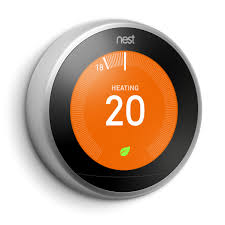Heating your home accounts for up to 60% of what you spend in a year on your energy bills (Energy Saving Trust). Therefore anything that you can do to improve the efficiency of your boiler and radiators will lead to significant savings.
Depending on your boiler’s age, a new efficient condensing one could save you up to £315 a year. However a new installed boiler will set you back anything from £1,800 to £3,000 depending on the boiler of your choice and the size of your house.
Adjusting your thermostat at home
If you only have one thermostat for your home, turning it down by 1°C would save around £145 a year, according to estimates from the Energy Saving Trust. For most people, the lowest comfortable temperature to set your heating is around 18°C.
What many home owners don’t realise is that their boiler can be made to run much more efficiently. The ‘flow temperature’ is the temperature your boiler heats up the water to before sending it off to your radiators. Most gas boilers are set up to operate at what is called 80/60 flow and return temperatures. This means the boiler heats up the water to 80°C. The water returns to the boiler after travelling around all your radiators at 60°C, having given off 20°C to the room.
However an 80/60C flow is too high for a condensing gas boiler to achieve the A-rated efficiencies claimed by the manufacturers. Your installer should have reduced the flow temperature to give the boiler a chance to run in what is known as ‘condensing mode’ as much as possible. This is when you will make a decent level of savings.
Efficiently running your heating in your home
The correct temperature setting for heating on a boiler is ‘as low as possible’, but as a guide most older homes can run their heating systems at 60°C and newer homes at 50-55°C. They start to reach their very highest efficiency potential at 45°C flow temperature or lower, but this can be too low for older properties.
Ultimately how low you can turn your flow temperature down will depend on the size of your radiators, how well insulated your home is and your thermostat temperature. For homes with modern double glazing, cavity walls and good levels of loft insulation you should be able to drop your flow temperature down with no impact on comfort. Even older homes, particularly terraced houses, will be able to do this if they have been modernised and draft proofed.
Smart heating in your home
There are also a raft of smart heating controls like Nest and Hive that allow you to control your home heating via and App. Why have your heating on when no one is at home? Or turn the heating on remotely when you are on your way home? If you add smart thermostatic radiator valves to your smart heating controls you can really start to make savings. At Carter Electrical we recommend fitting Nest and have good experiences with that brand.
Thermostatic radiator valves and a smart heating controller allow you to divide up your home into various zones and then offer smart heating in each zone, so your guest bedroom is heated only when required, the master bedroom is warm in the morning and at bedtime, and the kitchen is cosy at breakfast and tea time.
Get in touch if you would like more advice or if we can help with any electrical and heating issues.

